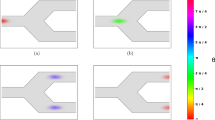Abstract
A generalization of the familiar de Broglie-Bohm interpretation of quantum mechanics is formulated, based on relinquishing the momentum relationship p=∇S and allowing a spread of momentum values at each position. The development of this framework also provides a new perspective on the well-known question of joint distributions for quantum mechanics. It is shown that, for an extension of the original model to be physically acceptable and consistent with experiment, it is necessary to impose certain restrictions on the associated joint distribution for particle positions and momenta. These requirements thereby define a new class of possible models. In pursuing this line of reasoning, the main contributions of this paper are (i) to identify the restrictions that must be imposed, (ii) to demonstrate that joint distribution expressions satisfying them do exist, and (iii) to construct a sample model based on one such joint distribution.
Similar content being viewed by others
References
D. Bohm,Phys. Rev.,85, 166, 180 (1952).
L. de Broglie,Non-Linear Wave Mechanics, (Elsevier, Amsterdam, 1960).
F. J. Belinfante,A Survey of Hidden-Variables Theories (Pergamon, Oxford, 1973).
D. Bohm and B. J. HileyThe Undivided Universe (Routledge, London, 1993).
P. R. Holland,The Quantum Theory of Motion (Cambridge University Press, (Cambridge, 1995).
E. Madelung,Z. Phys.,40, 332 (1926).
T. Takabayasi,Prog. Theor. Phys. 8, 143 (1952);9, 187 (1953).
M. Schönberg,Nuovo Cimento 12, 103 (1954).
D. Bohm and J.-P. Vigier,Phys. Rev. 96, 208 (1954).
D. Bohm, R. Schiller, and J. TiomnoSuppl. Nuovo Cimento 1, 48 (1955).
T. Takabayasi,Prog. Theor. Phys.,11, 341 (1954).
E. Wigner,Phys. Rev.,40, 749 (1932).
L. Cohen,J. Math. Phys.,7, 781 (1966).
L. Cohen, inFrontiers of Nonequilibrium Statistical Physics. G. T. Moore and M. O. Scully, eds., (Plenum, New York, 1986).
L. Cohen and Y. I. Zaparovanny,J. Math. Phys. 21, 794 (1980).
P. D. Finch and R. Groblicki,Found. Phys.,14, 549 (1984).
E. P. Wigner, inPerspectives in Quantum Theory, W. Yourgrau and A. van der Merwe, eds., (Dover, New York, 1979).
R. I. Sutherland.J. Math. Phys. 23, 2389 (1982).
M. Hillery, R. F. O'Connell, M. O. Scully, and E. P. Wigner,Phys. Rep. 106, 121 (1984).
Author information
Authors and Affiliations
Rights and permissions
About this article
Cite this article
Sutherland, R.I. Phase space generalization of the de Broglie-Bohm model. Found Phys 27, 845–863 (1997). https://doi.org/10.1007/BF02550344
Received:
Issue Date:
DOI: https://doi.org/10.1007/BF02550344




